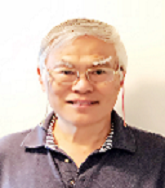Day 2 :
Keynote Forum
Gerald C. Hsu
eclaireMD Foundation
Keynote: Using Math-Physical Medicine to Study the Probability of Having a Heart Attack or Stroke Based on Combination of Metabolic Conditions, Lifestyle, and Metabolism Index
Time : 11:10-11:50

Biography:
Gerald C. Hsu received an honorable PhD in mathematics and majored in engineering at MIT. He attended different universities over 17 years and studied seven academic disciplines. He has spent 20,000 hours in T2D research. First, he studied six metabolic diseases and food nutrition during 2010-2013, then conducted research during 2014-2018. His approach is “math-physics and quantitative medicine” based on mathematics, physics, engineering modeling, signal processing, computer science, big data analytics, statistics, machine learning, and AI. His main focus is on preventive medicine using prediction tools. He believes that the better the prediction, the more control you have.
Abstract:
Abstract
Background and Aim:
The author has extended his 8-year T2D research along with ~1.5M data to examine the relationship among metabolic conditions, lifestyle, metabolism index, and the probability of having a heart attack or stroke.
Material and Method:
In 2014, he researched and built a metabolism model to measure the multiple interactions of four metabolic disease outputs and six lifestyle inputs.
Initially, he chose age, gender, race, family history, smoking, drinking, substance abuse, personal medical history, and waistline to establish a “static” baseline. He then applied the hemodynamics concept to develop a “dynamic” macro-simulated model for blood blockage and artery rupture.
He utilized 368,513 data which include 72,893 metabolic conditions (obesity, diabetes, hypertension, hyperlipidemia) and 295,620 lifestyle conditions (food, exercise, water, sleep, stress, daily life routine) within 2,274 days (1/2012-3/2018) to compute three different sets of risk probabilities separately. Finally, he integrated them into one overall risk probability. He also conducted sensitivity analyses to cover the probability variance by using different weighting factors (WF).
Results:
The risk probabilities are:
74% in 2000 (followed by three cardiac episodes 2001-2006)
From 69% in 2012 decrease to 26.4% in 2017 (compatible with 26.7% by Framingham Study)
WF sensitivity: +/- 10% to 18%
Conclusion:
The mathematical simulation results are validated by past 17-years health examination reports. This big data dynamic simulation approach using math-physical medicine will provide an early warning to patients with chronic disease of having a heart attack or stroke in the future.
Session Introduction
Si Nae Kang
Seoul National University College of Medicine
Title: The association between risk of metabolic syndrome and occupational, leisure-time and commuting physical activity in Korean workers: KNHANES 2014-2016

Biography:
Si Nae Kang is medical doctor specialized in Family Medicine, currently has been research fellow in Department of Family Medicine, Seoul National University Hospital, with experience in research, evaluation, teaching . She has special interest in Health promotion and Public health and conducted research on Korean smokers last year. She has developed pilot project of visiting care system for elderly, that is operated successfully now.
Abstract:
While the relationship of leisure time physical activity (LPA) and metabolic syndrome (MetS) is well documented, effect of occupational physical activity (OPA) on MetS is conflicting. Aim of this study is to examine the relationship between different type of physical activity and risk of metabolic syndrome using a representative sample of South Korean adults.
Study included 7057 workers (3795 men and 3262 women) aged 20 to 65 without cancer and arthritis at baseline, from the Korea National Health and Nutrition Examination Survey in 2014-2016. Information on OPA, LPA and commuting physical activity (CPA) were self-reported and blood pressure and biochemical determinations of the blood were also obtained. MetS was defined as the presence of three or more of the National Cholesterol Education Program-Adult Treatment Panel III criteria. Chi-square test and multiple logistic regression analysis were used to investigate relationship between different type of physical activity and MetS.
The prevalence of MetS was 25.7 % in the study subject. The percentages of active OPA in MetS and non-MetS groups were 6.7% and 5.0%, respectively. Compared with inactive level of LPA, sufficient level of LPA showed a significantly lower risk of MetS (OR 0.73, 95% CI 0.60-0.89) after adjustment for confounding factors. Conversely, active OPA showed increased risk of MetS (OR 1.09, 95% CI 0.77-1.52), but not reaching statistical significance. CPA was not associated with MetS.
LPA showed protective effect of MetS, but OPA showed marginal negative effect on MetS. This difference needs to be considered when recommendations for prevention of MetS are developed.
Gong Deuk Bae
Lee Gil Ya Cancer and Diabetes Institute
Title: Effect of liquiritigenin on apoptotic beta-cell death by palmitate-induced lipotoxicity in INS-1 cells

Biography:
Gong Deuk Bae is a PhD course student in Gachon university. His research topic is The effect of natural products on the prevention and treatment of type 2 diabetes focusing on pancreatic beta-cells.
Abstract:
Objective: Activation of estrogen receptor signaling plays an important role to preserve functional beta‑cell mass in treatment of diabetes. Liquiritigenin (LQ), a flavonoid isolated from Glycyrrhiza uralensis, is an estrogenic compound which acts as an agonist for the estrogen receptor β. In this study, we investigated protective effect of LQ on palmitate (PA)-induced apoptosis in INS-1 cells.
Methods: To examine effect of LQ on beta cells, glucose stimulated insulin secretion (GSIS) by enzyme immunoassay (EIA) method and cell viability by MTT were measured in rat beta-cell line INS-1 cells. To induce lipotoxicity, PA (400 μM) was treated for 24 h and amount of apoptotic cells were analyzed using a flow cytometer with annexin-V staining. Expression level of apoptotic proteins and endoplasmic reticulum (ER) stress markers were analyzed by western blot analysis after LQ treatment. Tunicamycin and thapsigargin were used to ER stress inducer and AKT inhibitor (AKTi-1/2) was used to inhibit LQ-induced AKT phosphorylation at ser 473.
Results: Exposure of INS-1 cells to 5 μM of LQ significantly increased GSIS as well as cell viability. PA treatment increased annexin-V stained cells and apoptotic proteins such as cleaved caspase-3, cleaved poly (ADP-ribose) polymerase and bax, but these increases were significantly inhibited by LQ treatment. LQ treatment inhibited cell death by ER stress inducers and PA induced ER stress marker proteins such as CHOP and phosphorylated forms of PERK and eIF2α was also significantly downregulated in LQ treated cells. LQ phosphorylated AKT at ser 473 via estrogen receptor element dependent pathway and blocking AKT signaling inhibited LQ induced decrease in level of phosphorylated PERK, consequently cell viability was not recovered.
Conclusion: Our data demonstrated that LQ has anti-apoptotic effect against PA induced lipotoxicity and AKT mediated ER stress inhibition was involved in the anti-apoptotic effect of LQ.
Philip James
W. P. Carey School of Business -Arizona State University, USA
Title: What every doctor needs to know about personal branding: 2019 and beyond

Biography:
Philip James is a marketing and communications consultant to the medical and architecture industries. Philip is an expert at building narratives and personal brands. His clients include hospitals, physicians, and industry associations. He has worked at ENDO, and the World Congress on Thyroid Cancer.
Abstract:
In this case, branding isn’t necessarily about logos and taglines. Simply put, a physician’s brand is essentially equal to his or her reputation. What patients think about you, how well-known you are in your community, your online presence–that is your brand. More and more patients are turning to online sources to find a physician. They may look at your website, but they are also likely consulting online reviews and listings as well. Branding is more important than ever if you want to attract the attention of these patients, whether you are just starting out or are already an established physician. During this session, the following topics will be covered:
- Five steps to brand building
- How to use digital tools and social platforms
- The danger of doing nothing
- Case Study: Dr. Netterville


